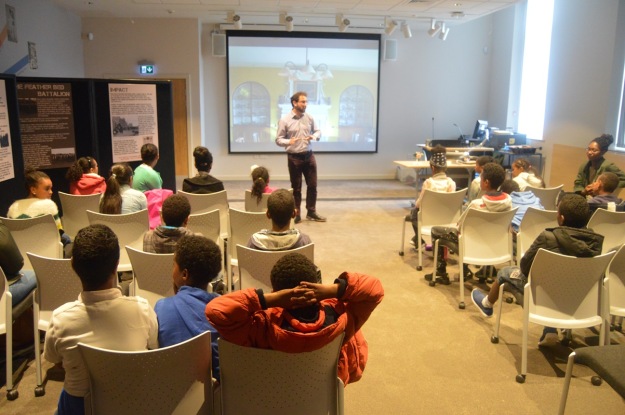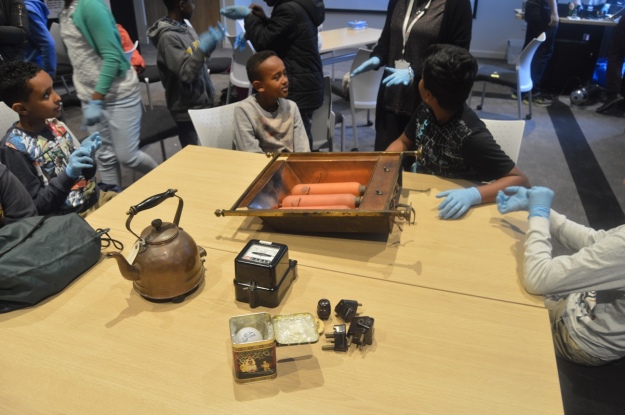I am currently working with Harewood House, in north Leeds, on a collaborative project called ‘Harewood’s Electricity Story’, researching the history of the electrification of the house and producing new interpretation and engagement activities based on our findings.
As part of this project, on Thursday 11 August I ran a workshop at the university for students from IntoUniversity, a national charity which provides local learning centres where young people are inspired to achieve. In particular they work with children from disadvantaged postcode districts who are statistically less likely to go to university or enter the professions than those in more advantaged areas, providing academic support, mentoring, and informal educational opportunities.

Introducing the workshop.
After a short performance from our three actors about the history of electrification at Harewood in the 1930s, I used artefacts from our museum collections to talk about the history of electricity supply and use in the home. These artefacts included two examples of early batteries – one wet cell one dry cell – with which I pointed out for example that country houses such as Harewood needed to supply their own electricity for a long time before they were connected to centralised power stations, and their electrical installations always included lots of large wet cell batteries. We also touched on the importance of measuring how much electricity you were using – so you knew what you were paying for!

Showing the students a nineteenth-century voltmeter.
In contrast to fears about being hurt by electricity – which had been discussed in the performance – I also discussed how some people in the late nineteenth and early twentieth centuries used mild electrical currents as a form of therapy. This last point I illustrated using a particularly interesting object from our collection: an electrical therapy machine designed for use at home, with two electrodes which the user would apply to parts of their body in order to administer a gentle electrical current. This, it was argued, was efficacious against many ills, such as headaches, nervous disorders, and even deafness and baldness. We believe ours dates from the late nineteenth-century, but devices such as these were certainly in use up until the 1920s and 30s.

One of our electrical home therapy kits (we have two).
Whilst presenting these artefacts, I talked to students about best practice in museum object handling: the importance of gloves, of using both hands to pick things up and holding them over tables. Next we gave the students the chance to handle some historic objects themselves. Although our own collections were too fragile to allow this, we hired out handling objects from Artemis, the object loans service run by Leeds Museums and Galleries. These domestic electrical appliances from the 19230s, 40s and 50s included hairdryers, a kettle, a wireless set, an iron, a toaster, a vacuum cleaner and a radiator, and students were very keen to put their gloves on and investigate. As a hands-on activity this was very popular; the children were happy to have the opportunity to explore these objects themselves. Knowing they were free to pick them up on their own was invaluable and a great experience.

Gloves on! The students handle some old electrical objects from Artemis.
The energy levels in the room were fantastic throughout; the students certainly seemed to have a lot of fun, and we really enjoyed having them!
—
The funding for this project comes from The Culture Capital Exchange, a new joint initiative of Arts Council England and the Higher Education Funding Council for England which provides seed funding grants up to £5000 for collaborative research projects between academics, specifically Early Career Researchers, and creative small-medium enterprises or individuals, including artists, performers and heritage organisations. You can read more about our project here, and for more information about this workshop see our blog post here.




